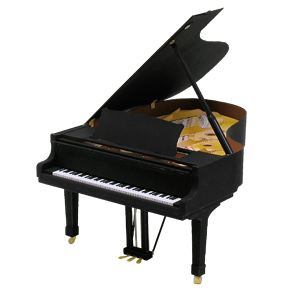Maqueta recortable de un magnífico piano de cola, la realización de esta maqueta es bastante complicada por la cantidad de piezas que la completan, podéis ver y descargar gratis una amplia colección de maquetas de instrumentos musicales haciendo clik Aquí. Esperamos que la completéis. También podéis seguirnos haciendo click en el Me Gusta de nuestra página de Facebook..
Piano de Cola / Grand Piano.
Download 25 páginas – Instrucciones (1/2) – Instrucciones (2/2)

Papercraft de un Piano de Cola / Grand Piano.
Curiosidades:
![]() Un piano de cola es un tipo de piano en el que las cuerdas y la caja de resonancia se encuentran en posición horizontal. Los pianos de cola tienen una tapa superior que se puede abrir, de manera que los sonidos producidos por las cuerdas salen al exterior sin barreras de ningún tipo. Es el más caro de los tipos, pues los «medianamente» buenos pueden llegar al tener un precio de 65.000€. Su tamaño puede variar dependiendo del fabricante y tipo de piano de cola fabricado, pero suelen oscilar entre los siguientes valores:
Un piano de cola es un tipo de piano en el que las cuerdas y la caja de resonancia se encuentran en posición horizontal. Los pianos de cola tienen una tapa superior que se puede abrir, de manera que los sonidos producidos por las cuerdas salen al exterior sin barreras de ningún tipo. Es el más caro de los tipos, pues los «medianamente» buenos pueden llegar al tener un precio de 65.000€. Su tamaño puede variar dependiendo del fabricante y tipo de piano de cola fabricado, pero suelen oscilar entre los siguientes valores:
- piano de cola mignon: hasta 130 cm de longitud.
- piano de un cuarto de cola: de 131 hasta 189 cm de longitud.
- piano de media cola: de 190 hasta 225 cm de longitud.
- piano de tres cuartos de cola: de 226 hasta 255 cm de longitud.
- piano de gran cola: superiores a 256 cm de longitud.
Fuente: Wikipedia y http://cp.c-ij.com/.
![]() In grand pianos, the frame and strings are horizontal, with the strings extending away from the keyboard. The action lies beneath the strings, and uses gravity as its means of return to a state of rest. There are many sizes of grand piano. A rough generalization distinguishes the concert grand (between 2.2 and 3 meters long, about 7–10 feet) from the parlor grand or boudoir grand (1.7 to 2.2 meters long, about 6–7 feet) and the smaller baby grand (around 1.5 metres (5 feet)). All else being equal, longer pianos with longer strings have larger, richer sound and lower inharmonicity of the strings. Inharmonicity is the degree to which the frequencies of overtones (known as partials or harmonics) sound sharp relative to whole multiples of the fundamental frequency. This results from the piano’s considerable string stiffness; as a struck string decays its harmonics vibrate, not from their termination, but from a point very slightly toward the center (or more flexible part) of the string. The higher the partial, the further sharp it runs. Pianos with shorter and thicker string (i.e., small pianos with short string scales) have more inharmonicity. The greater the inharmonicity, the more the ear perceives it as harshness of tone. Wikipedia and http://cp.c-ij.com/.
In grand pianos, the frame and strings are horizontal, with the strings extending away from the keyboard. The action lies beneath the strings, and uses gravity as its means of return to a state of rest. There are many sizes of grand piano. A rough generalization distinguishes the concert grand (between 2.2 and 3 meters long, about 7–10 feet) from the parlor grand or boudoir grand (1.7 to 2.2 meters long, about 6–7 feet) and the smaller baby grand (around 1.5 metres (5 feet)). All else being equal, longer pianos with longer strings have larger, richer sound and lower inharmonicity of the strings. Inharmonicity is the degree to which the frequencies of overtones (known as partials or harmonics) sound sharp relative to whole multiples of the fundamental frequency. This results from the piano’s considerable string stiffness; as a struck string decays its harmonics vibrate, not from their termination, but from a point very slightly toward the center (or more flexible part) of the string. The higher the partial, the further sharp it runs. Pianos with shorter and thicker string (i.e., small pianos with short string scales) have more inharmonicity. The greater the inharmonicity, the more the ear perceives it as harshness of tone. Wikipedia and http://cp.c-ij.com/.
